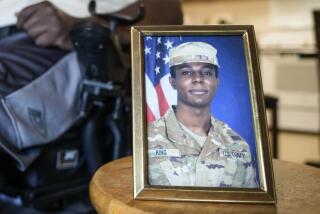Captors release video of U.S. soldier who went missing in Afghanistan
Posing an emotional new complication for the expanding U.S. military effort in Afghanistan, Islamic militants released a video of a captured American soldier whom U.S. military officials identified for the first time Sunday as Pvt. Bowe R. Bergdahl, 23, of Ketchum, Idaho.
The video marked the first time that militants have sought to take advantage of Bergdahl’s June 30 capture to mount a propaganda attack on President Obama’s decision to escalate U.S. involvement in the war.
The video also underscores the stakes for U.S. forces that have spent more than two weeks scouring eastern Afghanistan for clues to Bergdahl’s whereabouts.
The footage shows Bergdahl in apparent good condition, dressed in a traditional Afghan loose shirt and tunic, known as a shalwar khameez. His hair is short and he has a slight stubble of beard.
Responding to prompts from his captors, Bergdahl calls for U.S. forces to be returned home and voices worry that he may never again see his family.
“I’m scared I won’t be able to go home. It is very unnerving to be a prisoner,” he says at one point in the 28-minute recording. “I have my girlfriend who is hoping to marry. . . . I have a very, very good family that I love back home in America.”
U.S. military officials denounced the video as a violation of the laws of war. “The Taliban are using the soldier for propaganda purposes,” said Navy Lt. Robert Carr, a spokesman for U.S. forces in Afghanistan. “We are continuing to do everything possible to recover the soldier and are using all available assets to get him back safely and unharmed.”
Bergdahl, an Idaho native, is a member of the 1st Battalion, 501st Parachute Infantry Regiment, based at Ft. Richardson, Alaska. His unit is involved in counterinsurgency operations in a region thick with Taliban along the Pakistani border.
U.S. military officials said that neither Bergdahl’s capture nor the release of the video would alter their strategy in Afghanistan, where American forces are trying to bolster a wobbly central government and halt an alarming decline in security.
But now that Bergdahl has been publicly identified, he represents a propaganda weapon that his captors are likely to continue to use. The U.S. government had resisted naming Bergdahl since he was captured after straying from a U.S. base June 30 on the eastern edge of the country.
Bergdahl is the first American soldier captured in the conflict, but not the first hostage taken by Taliban-associated groups. A U.S. journalist, David Rohde of the New York Times, was abducted in Afghanistan in November 2008 and escaped last month from a compound in Pakistan where he was being held by militants.
In 2007, three U.S. soldiers were captured in Iraq. The body of one, Pfc. Joseph J. Anzack Jr. of Torrance, was found days later in the Euphrates River. The remains of his companions were not found until more than a year later.
Even if U.S. military officials can determine where Bergdahl is being held, they face the dilemma of whether a rescue attempt might only place him in greater danger.
“This is the most difficult circumstance,” said retired Army Maj. Gen. Bill Nash, a veteran of the 1991 Persian Gulf War and military intervention in Bosnia-Herzegovina. “They’re going to try to develop intelligence in order to find him, and then hopefully recover him. But they’re going to continue to conduct counterinsurgency operations at the same time.”
Since Bergdahl vanished, an intensive search has been underway involving U.S. and Afghan forces. Leaflets have been distributed calling for the safe return of a foreign “guest,” military officials said, and threatening retribution against anyone found to be concealing information about his whereabouts.
Within 48 hours of Bergdahl’s disappearance, the Taliban announced his capture. Mullah Sangin, a senior Taliban commander in Afghanistan’s southeast, said the soldier would be killed if the place where he is being held is attacked by Western forces.
Eastern Afghanistan has long been a volatile part of the country, bordering Pakistani tribal areas that have served as sanctuary for Al Qaeda and Taliban militants. Most of the foreign troops in the sector are American, and many are deployed in remote outposts near the border, like the one from which Bergdahl disappeared.
In the video, Bergdahl says that he was captured when he lagged behind on patrol. In the days after the abduction, however, American military officials speaking on condition of anonymity said he was believed to have simply walked away from his base in Paktika province.
Asked by his captors whether he had a message for his countrymen, Bergdahl offered a seemingly scripted reply: “To my fellow Americans who have loved ones over here who know what it’s like to miss them, you have the power to make our government bring them home.”
His military identification tags are shown in the video, which was ostensibly recorded July 14. A spokesman for the Idaho National Guard declined to identify Bergdahl’s parents and said they had asked for privacy.
But the family released a statement Sunday saying that they “hope and pray for our son’s safe return to his comrades and then to our family.”
--
laura.king@latimes.com
More to Read
Sign up for Essential California
The most important California stories and recommendations in your inbox every morning.
You may occasionally receive promotional content from the Los Angeles Times.










